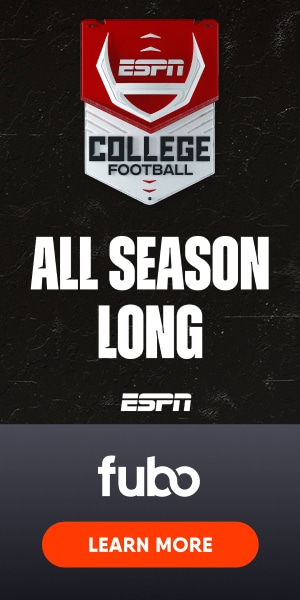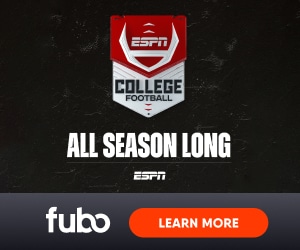Ready to watch the NFL? Learn all about what football positions do and take your experience to the next level with Fubo’s fan view.
Like with any job, responsibilities are split on a football field, with the different positions having different tasks they are supposed to accomplish. That’s what we are here to discuss and explain today, as we present you with a beginner’s guide to football positions and what they do in preparation for the 2023 college football and NFL season. We are going to explain all offensive and defensive football positions, their roles, skill sets and present you with famous players for each position. We’ll even cover special teams on top of offense and defense. With so much to cover, let’s jump right in.
WATCH NFL AND COLLEGE FOOTBALL THIS FALL: Sign up for a free trial with Fubo!
OFFENSIVE FOOTBALL POSITIONS
In football, offensive players are the ones who get the majority of the shine from fans, as watching your team score is the ultimate goal and the most exciting and rewarding feeling fans experience. Skill position players in football are the ones who throw passes, catch passes and run the ball, usually making them the stars of the team. On top of them, there are the blockers who give time for the quarterbacks to throw as well as open holes for running backs, known as the offensive line. There are 11 players allowed to be on the field at a time for offenses. They usually break down as follows.
- Quarterback (QB): The most important player on the field at all times, the quarterback, also commonly referred to as a QB, is charged with running the plays called by either the team’s head coach or offensive coordinator. The QB has to be like a coach on the field, getting teammates in the right spots, even sometimes audibling (changing) out of plays in favor of something they would rather run based on how the opposing defense is lined up. Quarterbacks are allowed to throw the ball down the field or even tuck it and run it themselves and are usually the biggest star on each team. Examples of big-name quarterbacks from the game today that you should know are Tom Brady (recently retired), Patrick Mahomes, Justin Herbert, Josh Allen, Joe Burrow and Lamar Jackson.
- Running back (RB): The running back position is pretty self-explanatory, as this is the position tasked with running the ball. Simple enough. The quarterback hands the ball off to running backs, who look for holes in the defense opened up by their offensive line, and try to run through it for big yardage. Some running backs even excel at running routes and catching the ball out of the backfield like wide receivers. Running backs need to be fast, quick and powerful in order to break tackles and gain even more yards. Some of the best running backs today are Nick Chubb, Derrick Henry, Christian McCaffrey, Josh Jacobs and Saquon Barkley.
- Full-back (FB): This position is getting exceedingly more rare in the modern NFL, though historically, it was very important. The full-back usually lines up in front of the running back, or to the opposite side of the quarterback, and is charged with running through holes before the running back, though without the ball, with their goal being to serve as another blocker and open up even bigger holes. The reason this position is dying out is that offenses today would prefer to pass the ball rather than run it, so they usually opt to have an extra wide receiver on the field rather than a limited full-back. Some of the best full-backs in NFL history include Jim Brown, Mike Alstott and Larry Csonka.
- Wide receiver (WR): One of the most glamorous positions in the NFL today is that of wide receiver, as they make the flashiest plays and score a lot of touchdowns. Wide receivers have the task of running routes and getting open in order to give the quarterback a downfield option to throw to. They even have to block sometimes when the offense is running it, though they usually aren’t all that great at winning their blocking matchups. Wide receivers need to have great hands in order to be reliable, as well as the speed, quickness and savviness to get open. Some of the best wide receivers today include Davante Adams, Tyreek Hill, Justin Jefferson, Ja’Marr Chase and Stefon Diggs.
- Tight end (TE): The tight end is a blend of a wide receiver and an offensive linemen. Usually much larger and stronger than wide receivers, there are plays in which tight ends have to line up next to the offensive line and serve as an extra blocker to open up holes for the running back to run through, and plays in which they pretend to block and then run a route down the field to catch passes from the quarterback. The tight end has become more and more important over recent years. Some of the best tight ends of the game today are Travis Kelce, George Kittle, Mark Andrews and Dallas Goedert.
- Offensive line (OL): This is the most complicated of the position groups despite them having the easiest jobs because there are five positions broken down to form a typical five-man offensive line. They are left tackle, left guard, center, right tackle and right guard. All each position has to do is block to keep their quarterbacks from being tackled (called a sack) and to open up holes for running backs to run through. That’s it. The center is the only one with an extra duty, and that’s to snap the ball to the quarterback when the quarterback hikes it. There are more intricacies to the position but those are the barebone basics of it. Oh, and offensive linemen aren’t allowed to catch passes or move the ball down the field in any way, so they really get very little shine from game to game.
WATCH NFL AND COLLEGE FOOTBALL THIS FALL: Sign up for a free trial with Fubo!
DEFENSIVE FOOTBALL POSITIONS
Despite not being as glamorous as offense, defensive football players are as important as their counterparts on the other side of the ball. They are tasked with stopping the opposing offense from scoring by tackling opponents, knocking down passes, intercepting the ball and forcing fumbles, as well as sacking the opposing quarterback to prevent them from throwing it. To play defense, a player must be fast, strong and have good awareness as to what’s going on around them.
- Defensive tackle (DT): Defensive tackles and defensive ends form what’s known as the defensive line, whose job it is to tackle running backs, sack quarterbacks and even knock down passes at the line of scrimmage, which is where the offensive line and defensive line do battle. In particular, the defensive tackle is usually one or two players on the interior of the defensive line, usually weighing over 300 pounds. Their job is more so to be run-stuffers, as opposing offenses usually like to run it up the middle with their running backs. Defensive tackles can also sack quarterbacks but it’s rarer because they aren’t as quick or explosive as defensive ends. Some of the best defensive tackles today are Chris Jones, Jeffrey Simmons, Quinnen Williams and the best of the bunch, by far, Aaron Donald.
- Defensive end (DE): While the defensive tackles line up in the middle of the defensive line, defensive ends line up to the outside. Their job is to use their quickness to get past the left and right tackles to tackle, or sack, the opposing quarterback. This is the most glamorous position in the front seven (defensive line plus linebackers), as many a star has been made in the past among players who rack up a lot of sacks every year. The best defensive ends in the game today include Myles Garrett, Micah Parsons, Nick Bosa and Von Miller.
- Linebacker (LB): Like the full-back, this position is becoming less important in the pass-heavy NFL of today, as defensive coordinators have started to opt to put an extra defensive back (cornerback or safety) on the field rather than using the three-linebacker setup that was so common in the past. Usually, there are two linebackers on the field at a time, with their job being to do a bit of everything, from blitz the quarterback (when you send an extra defender that isn’t a defensive lineman to attack the opposing QB), cover tight ends or running backs and knock down passes or stuff holes and stop running backs from rushing it down the field. Linebackers have to be more athletic than ever these days in order to improve their versatility, like players such as Fred Warner, Lavonte David and Demario Davis.
- Cornerback (CB): There are two types of defensive backs in football: cornerback and safety. The cornerback lines up closer to the opposing offense with their job being to defend or guard opposing wide receivers (sometimes opposing tight ends, too) to prevent them from getting open to catch passes. If passes get thrown in their direction, cornerbacks are expected to either knock the ball down, intercept the ball or tackle the receiver if he manages to catch it. Lockdown corners are crucial if you want to have a good defense today, with players such as Sauce Gardner, Jalen Ramsey, Darius Slay, Patrick Surtain II and Stephon Gilmore among the best the position has to offer today.
- Safety (S): Finally, safeties are the other kind of defensive back, and they line up at the deepest part of the defense, behind the linebackers. Safeties have to clean up any messes in front of them. If your leading tackler is your safety, that usually means you didn’t have a very good defense. Safeties have to knock down passes, cover for cornerbacks that get beaten by wide receivers by either knocking the ball down or tackling the ball carrier, and tackle running backs that managed to get past the defensive line and linebackers. They are like more athletic linebackers who need to be both fast and strong. Some of the best safeties today are Ryan Neal, Minkah Fitzpatrick and Tyrann Mathieu.
WATCH NFL AND COLLEGE FOOTBALL THIS FALL: Sign up for a free trial with Fubo!
SPECIAL TEAMS FOOTBALL POSITIONS
We conclude with special teams, who are important in football but very specific in what their jobs entail. Some plays, like kickoffs, point-after tries, field goals and punts, are handled solely by special teams. Special teams feature the only players who are allowed to kick the ball in American football.
- Punter (P): When a team fails to register a first down and gets to fourth down, that means they can either go for the first down with their last chance or punt the ball away to give possession to the other team further away from their own endzone, to give the opposing offense a further distance to go to score. When the team has to punt, that’s when the punter comes into play. He catches the ball and just punts it down the field, with the ball traveling very far and very high up in the sky.
- Kicker (K): On the other hand, if you have fourth down but are close enough to kick a field goal through the yellow uprights, that’s when your kicker comes in to try and earn your team three points. Anything within 50 yards is fairly makeable, with elite kickers even being able to make anything from within 60 yards, though that is rare. Kickers are also used after a team scores a touchdown and goes for the point-after try, worth one point, a kick from the 15-yard line, technically making it a 33-yard attempt. The best kickers today are Justin Tucker, Tyler Bass, Daniel Carlson, Harrison Butker and Jason Sanders.
- Kick returner (KR): To start off a game or second half, or after a team scores, that team has to kick the ball away to the other, usually using their kicker but sometimes their punter if they have a stronger leg. The job of the kick returner is to catch the ball and either do a fair catch, where their team will then start from their own 25-yard line, or bring the ball out and run it down the field. The best kick returners can even score touchdowns sometimes, though that is becoming more difficult with how far kickers are blasting it into the opposing endzone. The best kick returner ever, and probably the most famous, is Devin Hester.
- Punt returner (PR): The punt returner is similar to a kick returner with the difference being that they are catching punts as opposed to kickoffs, which is more difficult to do. Punt returners can also fair catch it or catch it and run down the field (if they have good blocking by their special teams) to try and score a touchdown.
- Long snapper (LS): This player is important and under-appreciated. Long snappers are in the game only for field-goal kicks and punts, and they have to snap the ball further distances than centers, either to the hands of their punters or to the person holding the ball for the kicker, known as holders. Holders are usually backup quarterbacks or punters.
WATCH NFL AND COLLEGE FOOTBALL THIS FALL: Sign up for a free trial with Fubo!
Ready to watch the NFL and college football?
If you want to watch the NFL or college football this fall and winter, the best time of the year, Fubo is the best streaming service option you can use by far. Fubo carries all of the major networks you need to watch NFL and college football, from the local affiliates in CBS and FOX to the national television game channels like ABC and ESPN. Fubo also carries NFL Network and NFL RedZone so you can catch all of the latest action and analysis around the sport all Americans love so much. Fubo even offers fan view, which lets you in on more of the action by showing you the latest scores and stats right in your Fubo app.
Sign up for Fubo and get a free trial today simply by following this link. We’re sure you won’t regret this decision.
Regional restrictions may apply.













